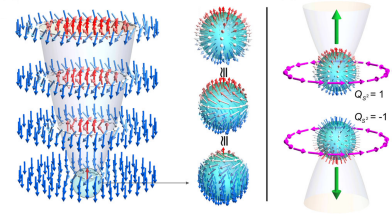08
Monopole-Induced Emergent Electric Fields in Ferromagnetic Nanowires

In a recent Phys. Rev. Lett. article, researchers at the Laboratory of Metal Physics and Technology (LMPT) have demonstrated that magnetization switching in ferromagnetic nanoparticles is linked to the dynamics of topological point defects, which form as Skyrmion lines and break via the creation of emergent magnetic monopoles. These move at speeds exceeding those of any other magnetic object known, and thus generate unprecedented solenoidal electric fields of several megavolts per meter.
Claire Donnelly has been awarded the SPS Award in Computational Physics and the Werner Meyer-Ilse Memorial Award

In August 2018, Claire Donnelly was awarded the SPS Award in Computational Physics, sponsored by COMSOL, and the Werner Meyer-Ilse Memorial Award. We congratulate her on these awards as well as for two awards earlier on in the year: the ETH Medal for an outstanding doctoral thesis and the American Physical Society Richard L. Greene Dissertation Award, recognizing doctoral thesis research of exceptional quality and importance.
Inverted Worlds in Multiferroics

Multiferoics are materials known for their coupled magnetic and electric properties ― but they have much more to offer!
Metastable Quasicrystal-induced Nucleation in a Bulk Glass-forming Liquid

In a recent PNAS publication, researchers at the Laboratory of Metal Physics and Technology (LMPT) have demonstrated that crystal nucleation from the melt may generally occur via an intermediate nucleation of metastable quasicrystals. This transition path was observed with a newly developed method of “up-quenching”, which can yield the discovery of hidden transient phases that are key to understanding the nucleation and crystallization behavior in metallic, polymeric and biological systems.
Echos from the Quantum World

A collaboration on experiments headed by the Laboratory of Multifunctional Ferroic Materials (Manfred Fiebig) shows that certain materials emit optical echo pulses that reveal direct information about the quantum-mechanical nature of these systems.
A New Chemical Design for The Surface of Biomaterials

A research team led by Dr. Edmondo M. Benetti (Polymer Surfaces Group) and Prof. Richard Hoogenboom (Ghent University) carried out a comprehensive, comparative analysis of the structural and physicochemical properties by non-ionic polymer “brush” surfaces that are aiming to replace poly(ethylene glycol) (PEG) in the functionalization of exposed surface of biomaterials.